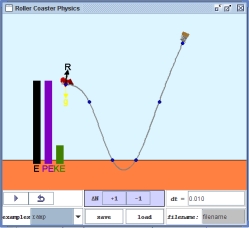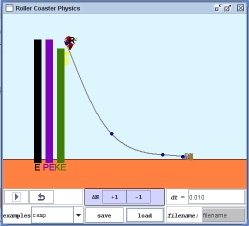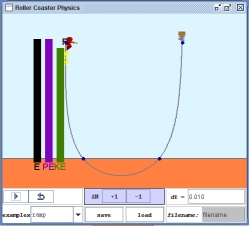

The energy of the car on the roller coaster is determined by the initial height of the car, since the car starts form rest. That energy is controlled by the first control point of the track. Select the up and down example, and change the starting height of the track. What happens to the total energy E and the potential energy PE? Start the simulation by hitting the play button. How far up the other side of the track does the car get? How does the maximum height attained by the car on the right side of the track depend upon the initial height of the car?
Select the single loop example track. What happens to the total energy E and the potential energy PE as the initial height is changed? When the simulation is played, what happens to the motion of the car when the initial height is changed? Is there a relationship between the initial height of the car and the size of the loop when the car barely makes it around the loop?

Select the ramp example track, remove all but four control points (using the ΔN -1 button) and move the remaining control points to create a ramp that levels out, as shown above. Play the simulation and observe the reaction force at different parts of the track. This reaction force corresponds to “how heavy the rider feels”. Change the steepness of the left side of the track and observe the changes in reaction force. Is it possible to get the reaction force to be exactly zero? What would zero reaction force feel like in the “real world”?

Change your ramp track into a fairy symmetric U shape, as shown above. Play the simulation and observe the reaction forces. Now make the bottom part of the track narrower by moving the bottom two control points closer together. What happens to the reaction force?
Select the loop example track and play the simulation. Where on the loop is the reaction force greatest? Where is it the least? Now lower the starting height for the car so that the reaction force at the top of the loop is as small as you can make it. (This will have to be done by trial and error.) What would this feel like to a rider? Now adjust the starting height to be as low as possible and still have the car make it around the loop. What happens in this case to the reaction force at the top of the loop? What would this feel like to the rider, and is he glad he buckled his seat belt?